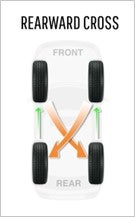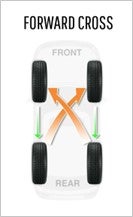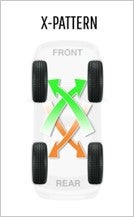Get Your Tires Rotated at Fort Dodge Ford
Just like your shoes can have a significant effect on your feet, legs, and even back, so too can tires affect your vehicle. Improper shoes can cause pain for your body in the same way that improperly cared-for tires can cause damage to your car.
Your tires affect your driving experience in a multitude of ways. They can significantly affect the way your car accelerates, handles, steers, and brakes. Through regular wear and tear, however, your tires can become misaligned, which can cause them to wear unevenly.
When your tires are misaligned for long enough, they can cause uneven wear and tear on your tires, leading to a decreased life expectancy and other issues in your vehicle. This is why it is highly recommended to regularly get your tires aligned and rotated - keeping your tires aligned prevents uneven wear and tear, while rotating them can help even out the wear and tear to lengthen the lifespan of your tires.
What Is Tire Rotation?
While you might have heard the advice to get your tires rotated, many people don’t know what that entails. After all, don’t your tires rotate when you are driving?
While the rotation of the wheels is what gets your car moving, it isn’t what people are referring to when they talk about tire rotation. A tire rotation is actually when the tires of a car are moved to a different position on the body of the car. For example, switching the left tires with the right tires or the front with the back.
This is to ensure that the tires are not always being worn down in the same place, which can reduce traction and cause weak spots. So if your tires were tilted inward, for example, causing uneven tread wear on the interior edge of the tires, rotating them so that the left and right tires switched would mean that wear and tear would be shifted to the less-worn part of the tire, letting the tires wear evenly.
Different types of vehicles will usually require different types of rotations. A front-wheel-drive car, for example, will usually have the front wheels moved straight back and the back wheels moved directly forward without switching sides. This prevents uneven tread wear since the front of your vehicle is generally heavier than the rear.
In all-wheel-drive vehicles or rear-wheel drive vehicles, however, the rear tires will be moved forward without switching sides, while the front tires will move to opposite sides in addition to being moved backward.
How Often Should I Rotate My Tires?
While it is important to rotate your tires regularly, every vehicle and driver is different. Generally, the recommended interval for rotating your tires is every 5,000 to 8,000 miles.
This tire rotation schedule is a little less frequent than you would get an oil change, depending on the type of oil your vehicle uses, although many drivers decide to have their tires aligned and rotated every time they get their oil changed for the sake of convenience.
If you’re unsure how often to rotate your tires in your specific vehicle, check your owner’s manual for a specific recommendation from your vehicle manufacturer. Sometimes, however, there are signs that you need to get a tire rotation sooner, such as noticeably uneven tire wear, loss of tire pressure, and vibration when driving at higher speeds.
Regularly rotating tires also gives you the chance to visually inspect your tires for damage, check the air pressure, and check the tread depth.
Why Is Tire Rotation Important?
Rotating tires on vehicles isn’t just randomly repositioning tires but rather using tire rotation patterns chosen based on the tire wear for your specific vehicle.
Regardless of how your tires are rotated, rotating tires is an important component of your vehicle’s upkeep. In fact, having your tires rotated regularly might even be required to keep your tires covered under warranty.
Overall, there are a handful of important reasons to keep tire rotation as a part of your routine vehicle maintenance.
Even Treadwear and Tire Life
Most importantly to the longevity of your tires and the thickness of your wallet, regularly rotating your tires is important because it spreads wear and tear across all four tires so that their tread life is maximized and you don’t have to replace the tires as frequently.
This is because each specific wheel position on your vehicle faces different demands. The front tires on a front-wheel drive vehicle, for example, experience a greater demand due to the torque and friction that is required for turning, accelerating, and braking. Different positions on vehicles of varying drivetrains can cause more or less wear on any specific tire.
Even if your vehicle is properly aligned (which can reduce uneven wear and tear on your treads), tires still need to be rotated regularly to counteract the uneven wear characteristics that are associated with each wheel position on the vehicle.
For new tires, it is even more important to rotate the tires before the 5,000-mile mark since fresh, deep tire tread is the most susceptible to uneven wear.
Smoother Ride
As we mentioned before, each tire position causes different types of wear at different rates. Having your tires aligned prevents uneven tread wear. That uneven wear can cause issues with the smoothness of your ride.
Tires that are out of balance can also cause an annoying vibration, especially at higher speeds.
Enhanced Safety
Keeping the treads on your tires evenly worn also helps things like traction and handling, which are critical components when driving in inclement weather such as rain, snow, or ice. The treads of your tires allow your vehicle to grip the road. When you wear down only one section of the tire, you reduce the traction of the wheel, which can lead to potentially dangerous situations on the road.
These factors can also affect turning and cornering, braking performance (especially in regard to sharp stops), and overall safety, especially on wet or icy roads.
Better Fuel Efficiency
When your tires are worn unevenly, they also can’t maintain uniform contact with the road, which can mean increased friction. This increased friction means that your engine has to work harder and use more fuel to move. Therefore, getting a tire rotation can help prevent this excess friction and improve your vehicle’s fuel economy.
Longer-Lasting Tires And Suspension
The previously mentioned vibration, especially at higher speeds, can also cause damage to your drivetrain and suspension. Especially for an all-wheel drive vehicle, evenly worn tires reduce the stress on the drivetrain and engine, which can keep your vehicle in better shape for longer.
What Tire Rotation Pattern Should I Utilize?
There are a variety of different tire rotation patterns to utilize, depending on how many wheels your vehicle has, the type of wheels you’re using, whether your vehicle is front, rear, all, or four-wheel drive, whether your tires are directional or non-directional, whether or not your tires are the same size on the front and rear of your vehicle and more.
Not sure what tire rotation pattern to use? Just ask a professional. Just remember: following a tire rotation, adjust all tires to the vehicle manufacturer’s recommended pressure.
Here are some of the different rotation patterns you can expect to see commonly in the industry.
For Tires That Are Of Uniform Size And Non-Directional

Rearward Cross
For rear-wheel drive vehicles, the rearward cross pattern is recommended. This is when rear tires are moved to the forward axle and kept on the same side of the vehicle. In other words, rear tires are moved directly forward. The front wheels, on the other hand, are moved from the front axle to the rear axle, as well as to the opposite side of the vehicle.
X-Pattern
For 4-wheel drive and all-wheel drive vehicles, including sedans, lightweight trucks, and more, all tires are moved diagonally from their starting positions. This means that rear tires are moved to the front axle and to opposite sides, while front tires are moved to the rear axle and to opposite sides. From above, if you drew arrows from each wheel’s starting position to their new position, it would make two X shapes.

Forward Cross
As the most common pattern for front-wheel drive vehicles, the forward cross consists of the front wheels being moved directly back while the rear tires are moved forward and switched sides, opposite from the rearward cross.
For Tires That Are Of Uniform Size And Non-Directional With A Full-Size Spare Tire
When you have a full-size spare tire, you’ll want to rotate the spare in with the other four to ensure that all of the tires on your vehicle have even tread wear. This is especially important for 4-wheel drive and all-wheel drive vehicles since even minor differences can cause unnecessary strain on your vehicle’s drivetrain.
Rearward Cross (Rear-Wheel Or 4-Wheel Drive Vehicles)
This is similar to the standard rearward cross but takes into consideration the spare tire. In this situation, both tires on the rear axle move directly forward to the front. The spare tire moves to the right side of the rear axle, while the front right tire moves backward and across to the rear left axle position. The right front tire becomes the new spare tire.
Forward Cross (Front-Wheel Drive Vehicles)
Again, similar to the aforementioned forward cross, the tires on the rear axle are moved diagonally forward, placing the rear left tire into the front right position, and the rear right tire into the front left position. The spare tire is moved to the rear right position, which leaves the front left tire to go to the rear left position and the front right tire to become the new spare.
For Differently-Sized And Directional Tires
Side-To-Side (For Differently-Sized Tires On The Front And Rear Axles)
Since tires in this situation are differently sized, tires are simply switched with their same-sized partner while remaining on the same axle. This means that the rear left becomes the rear right and vice versa. The same goes for the front tires.
Front-To-Back (For Directional Tires)
In this situation, all tires are switched from one axle to the other while remaining on the same side of the vehicle. For example, the rear right tire becomes the front right tire and vice versa, while the left front and rear also trade positions.
Other Types of Rotations
Six-Tire Rotation (Dually trucks)
In the case where a vehicle has more than four (or five, counting a full-sized spare) tires, there is a little more that goes into the tire rotation. The main commonplace example of this is for dually trucks, with two front tires and four rear tires.
In this case, the tire rotation pattern resembles two triangles, one for the three wheels on the driver’s side and one for the three wheels on the passenger side. For each side, the outer dual tire becomes the inner dual tire, the inner dual tire becomes the front tire (the steer position), and the front tire becomes the outer dual position.
Get Your Tires Rotated At Fort Dodge Ford
For some, these different types of rotations can be hard to picture. The good news is that you don’t have to worry about rotating your tires on your own. As mentioned previously, most drivers get their tires rotated when they get an oil change, which means you can take fewer trips to the mechanic.
If you’re looking for a reputable place to take your vehicle for service, look no further than Fort Dodge Ford. Our service center can handle all of your car maintenance needs, from an oil change to a wheel alignment, not to mention a tire rotation. We will inspect your tires and rotate them to the best position for the unique wear and tear on your tires.
While you’re at it, you can even wander our lot to take a look at all of the vehicles we have available. Give us a call or visit our website to set up a service appointment today.
| Monday | 8:00AM - 8:00PM |
| Tuesday | 8:00AM - 8:00PM |
| Wednesday | 8:00AM - 8:00PM |
| Thursday | 8:00AM - 8:00PM |
| Friday | 8:00AM - 6:00PM |
| Saturday | 8:00AM - 5:00PM |
| Sunday | Closed |
| Monday | 7:00AM - 7:00PM |
| Tuesday | 7:00AM - 7:00PM |
| Wednesday | 7:00AM - 7:00PM |
| Thursday | 7:00AM - 7:00PM |
| Friday | 7:00AM - 6:00PM |
| Saturday | 8:00AM - 5:00PM |
| Sunday | Closed |
| Monday | 7:30AM - 5:30PM |
| Tuesday | 7:30AM - 5:30PM |
| Wednesday | 7:30AM - 5:30PM |
| Thursday | 7:30AM - 5:30PM |
| Friday | 7:30AM - 5:30PM |
| Saturday | 8:00AM - 5:00PM |
| Sunday | Closed |


